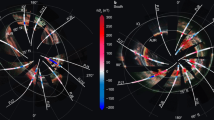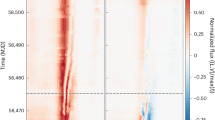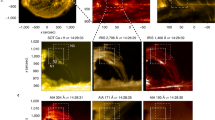Abstract
Narrow-band jovian kilometric radiation (nKOM) is distinguishable from broad-band jovian kilometric radiation (bKOM), both discovered by the Voyager spacecraft1–3, by its generally lower intensity, its more restricted range of centre frequency, its narrower bandwidth, and its temporally less sporadic nature4. When observed at northern and southern magnetic latitudes nKOM polarization was predominantly left-handed and right-handed respectively, opposite to bKOM4,5. At nearly the same longitude on consecutive jovian rotations nKOM sometimes lagged the magnetic field rotation4 by 3–5%; no such lag was detected for bKOM6,7. It was proposed that bKOM is produced within ˜2° of the magnetic equator in the outer lo plasma torus by conversion of electrostatic upper hybrid (ESUH) waves to ordinary (O) mode electromagnetic radiation via a radio window8,9. Here we show that nKOM seems to be produced by the same conversion process, also operating in the lo torus, but at latitudes ≥8°. The difference in latitude for nKOM and bKOM sources stems from the condition required for mode conversion that the plasma density gradient should be normal to the magnetic field vector. The difference in these locations allows an explanation of most of the similarities and differences between the two radiations.
This is a preview of subscription content, access via your institution
Access options
Subscribe to this journal
Receive 51 print issues and online access
$199.00 per year
only $3.90 per issue
Buy this article
- Purchase on Springer Link
- Instant access to full article PDF
Prices may be subject to local taxes which are calculated during checkout
Similar content being viewed by others
References
1. Warwick, J. W. et al. Science 204, 991–995 (1979). 2. Warwick, J. W. et al. Science 204, 995–998 (1979). 3. Scarf, F. L. et al Science 204, 991–995 (1979). 4. Kaiser, M. L. & Desch, M. D. Geophys. Res. Lett. 7, 389–392 (1982). 5. Daigne, G. & Leblanc, Y. J. geophys. Res. 91, 7961–7969 (1986). 6. Desch, M. D. & Kaiser, M. L. J. geophys. Res. 85, 4248–4256 (1980). 7. Leblanc, Y. & Daigne, G. /. geophys. Res. 90, 12073–12080 (1985). 8. Jones, D. Nature 324, 40–42 (1986). 9. Jones, D. & Leblanc, Y. Ann. Geophys. 5A, 29–38 (1987). 10. Jones, D. Nature 228, 225–229 (1980). 11. Bagenal, F. et al. J. geophys. Res. 90, 1755–1757 (1985). 12. Divine, N. & Garrett, H. B. J. geophys. Res. 88, 6889–6903 (1983). 13. Jones, D. /. geophys. 52, 158–166 (1983). 14. Connerney, J. E. P. et al J. geophys. Res. 86, 8370–8384 (1981). 15. Barbosa, D. D. & Kurth, W. S. / geophys. Res. 85, 6729–6742 (1980). 16. Dessler, A. J. Physics of the Jovian Magnetosphere (ed. Dessler, A. J.) 498–504 (Cambridge University Press). 17. Stone, R. G. et al. The International Solar Polar MissionIts Scientific Investigations (eds Wenzel, K. P., Marsden, R. G. & Battrick, B.) 185–207 (ESA Publications Division, ESTEC, The Netherlands, 1983). 18. Jones, D. et al Nature (submitted). 19. Jones, D. Nature 306, 453–456 (1983).
Author information
Authors and Affiliations
Rights and permissions
About this article
Cite this article
Jones, D. Io plasma torus and the source of jovian narrow-band kilometric radiation. Nature 327, 492–495 (1987). https://doi.org/10.1038/327492a0
Received:
Accepted:
Issue Date:
DOI: https://doi.org/10.1038/327492a0
This article is cited by
-
Quantitative methods for waves in space plasmas
Space Science Reviews (1990)
Comments
By submitting a comment you agree to abide by our Terms and Community Guidelines. If you find something abusive or that does not comply with our terms or guidelines please flag it as inappropriate.



